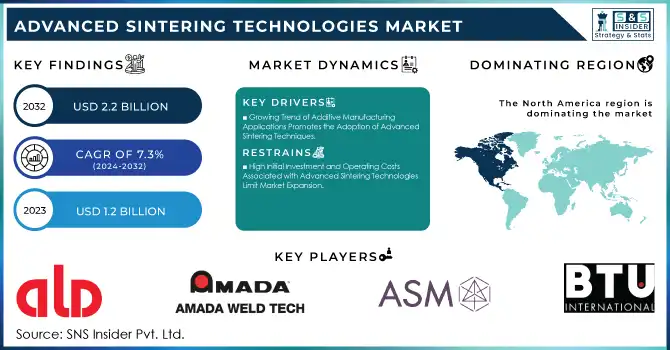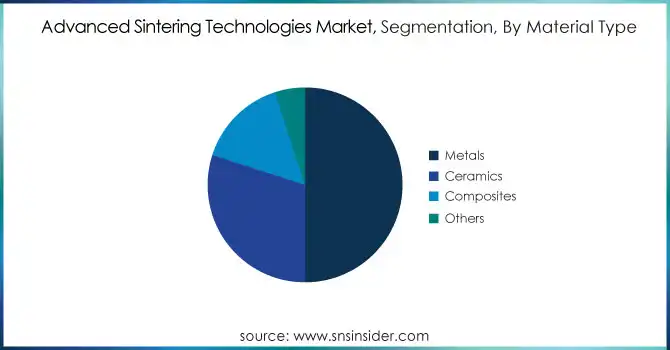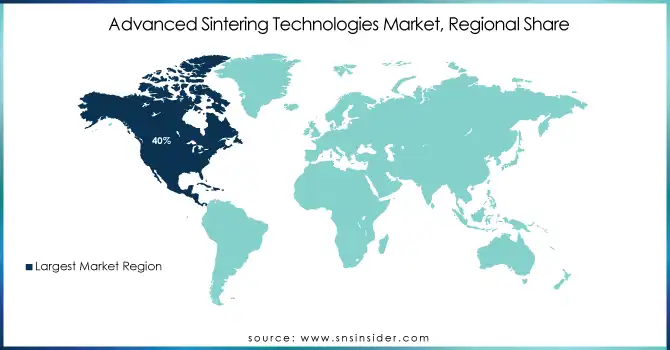Advanced Sintering Technologies Market Report Scope & Overview:
The Advanced Sintering Technologies Market Size was valued at USD 1.2 billion in 2023 and is expected to reach USD 2.2 billion by 2032 and grow at a CAGR of 7.3% over the forecast period 2024-2032.

Get More Information on Activated Carbon Market - Request Sample Report
Advanced sintering technologies, including Spark Plasma Sintering (SPS), have seen significant advancements, driven by the demand for higher-quality materials across multiple industries. California Nanotechnologies, in October 2024, unveiled a cutting-edge SPS facility aimed at supporting innovations in aerospace, automotive, and medical fields. This new facility will allow the company to develop advanced materials with superior properties, offering rapid prototyping and manufacturing capabilities for complex components. Additionally, companies such as DSB Technologies (formerly SSI Sintered Specialties) have rebranded to reflect a renewed focus on the integration of advanced sintering technologies with new material innovations. The rebranding, completed in May 2022, underscores the company’s commitment to advancing powder metallurgy and sintering methods, marking a significant step in its strategy to optimize manufacturing solutions and expand into new markets. This shift aligns with broader industry trends that emphasize performance, precision, and sustainability.
In the collaborative effort for sintering optimization, HP and Elnik, in November 2023, focused on improving sintering processes for the HPS S100 metal jet printer. This collaboration highlights the ongoing drive to refine sintering processes for additive manufacturing applications, ensuring optimal properties and reliability in final printed metal components. Such developments demonstrate the industry's focus on enhancing the sintering process for a range of materials, from high-performance alloys to complex composites. These strides are indicative of the broader trends of innovation and expansion in advanced sintering technologies, reflecting the industry's continuous effort to push the boundaries of what can be achieved in manufacturing high-quality components for diverse applications.
Market Dynamics:
Drivers:
-
Increasing Investment in Research and Development of Advanced Sintering Technologies Enhances Market Potential
With the rapid development of new materials and techniques, research and development (R&D) investments have become a key driver for advanced sintering technologies. Companies and research institutions are focusing on enhancing the performance and efficiency of sintering processes, such as Spark Plasma Sintering (SPS) and Hot Isostatic Pressing (HIP), to meet the growing demand for high-performance materials. The aerospace, automotive, and medical sectors require materials that can withstand extreme conditions, and sintering technologies provide solutions for these applications. Additionally, advancements in R&D help in lowering production costs and improving the precision of the materials produced, thus enhancing the overall competitiveness of sintering techniques in the global market. This continuous innovation is critical to ensuring the market's long-term growth potential, as companies strive to meet the evolving needs of industrial applications.
-
Rising Demand for High-Performance Materials in Aerospace and Automotive Sectors Fuels Market Growth
-
Growing Trend of Additive Manufacturing Applications Promotes the Adoption of Advanced Sintering Techniques
Additive manufacturing, or 3D printing, has experienced significant growth across various industries, prompting the increased adoption of advanced sintering technologies. These technologies are vital for achieving the material properties necessary for high-performance 3D-printed components. Sintering processes such as Microwave Sintering and Field-Assisted Sintering are integral to creating components with high strength, fine details, and material homogeneity, which are essential for industries like aerospace, automotive, and healthcare. As the demand for 3D-printed parts continues to grow, particularly in sectors that require customized solutions or complex geometries, sintering technologies are expected to play an increasingly important role in enhancing the quality of additive manufacturing products. This growing trend of integrating sintering methods with additive manufacturing is expected to significantly contribute to the market’s expansion
Restraint:
-
High Initial Investment and Operating Costs Associated with Advanced Sintering Technologies Limit Market Expansion
Opportunity:
-
Integration of Artificial Intelligence and Automation in Sintering Processes Enhances Efficiency and Productivity
The integration of artificial intelligence (AI) and automation into sintering processes offers significant opportunities for improving operational efficiency and reducing costs. AI can be used to optimize sintering parameters, monitor the quality of products in real-time, and enhance the overall control of the production process. Automation can streamline the manufacturing workflow, reduce human error, and improve overall consistency and productivity. These technological advancements allow manufacturers to achieve better outcomes in terms of material quality and production speed. By adopting AI and automation, companies can also lower operational costs, making advanced sintering technologies more accessible and cost-effective for a broader range of industries. This technological integration presents a clear opportunity for advancing sintering techniques and expanding their market share.
-
Development of Customized Solutions for Specific Applications Expands Market Reach
As industries demand more tailored solutions, there is a growing opportunity for developing customized sintering technologies to meet specific application requirements. Advanced sintering methods can be adjusted to produce components with unique properties, such as enhanced thermal conductivity, strength, and resistance to wear. This customization is particularly valuable in industries like aerospace, automotive, and healthcare, where the performance of materials can significantly impact the end product's reliability and efficiency. By offering bespoke sintering solutions for niche markets, companies can differentiate themselves in the competitive landscape and capture a more diverse customer base. As more industries seek specialized solutions, the market for customized advanced sintering technologies will continue to grow.
Sustainability and Environmental Impact of Advanced Sintering Technologies
|
Sustainability Aspect |
Description |
|
Energy Efficiency |
Advanced sintering technologies, like Spark Plasma Sintering, consume less energy than traditional methods, reducing overall carbon emissions. |
|
Material Waste Reduction |
Sintering processes often lead to higher material utilization rates, minimizing scrap and waste in manufacturing. |
|
Use of Recyclable Materials |
Many sintering applications utilize recycled metals and powders, promoting circular economy principles. |
|
Lower Emission Technologies |
Innovations in sintering equipment have led to systems that emit fewer pollutants, enhancing air quality and compliance with environmental regulations. |
|
Sustainable Production Practices |
Companies are adopting sustainable practices, such as using eco-friendly materials and renewable energy sources in their operations. |
Advanced sintering technologies are increasingly focused on sustainability, addressing environmental concerns while optimizing manufacturing processes. By improving energy efficiency and reducing material waste, these technologies minimize the ecological footprint associated with production. The use of recyclable materials further promotes sustainability by supporting circular economy practices. Additionally, lower emission technologies contribute to better air quality, ensuring compliance with stringent environmental regulations. As the industry embraces sustainable production practices, it not only benefits the environment but also enhances its overall market viability.
Key Market Segments
By Type
In 2023, the Spark Plasma Sintering (SPS) segment dominated the advanced sintering technologies market, achieving a market share of 45%. This technology has gained significant traction due to its ability to produce high-density materials rapidly while maintaining superior mechanical properties. SPS operates by applying a pulsed electric current directly to the powder material, resulting in fast heating and sintering, which minimizes grain growth and preserves the desired microstructure. Industries like aerospace and automotive benefit immensely from SPS because it allows for the creation of complex geometries and enhances performance characteristics, such as strength and toughness. For example, titanium alloys used in aerospace components are often processed through SPS, achieving optimal performance with reduced production time. Additionally, ongoing innovations and investments in SPS technology by key players, alongside its environmentally friendly approach compared to traditional sintering methods, further solidify its dominance in the market. As industries increasingly prioritize high-performance materials, SPS is expected to continue leading the advanced sintering technologies landscape.
By Material Type
In 2023, the metals segment dominated the advanced sintering technologies market, holding a market share of 50%. The extensive application of metals in high-performance sectors such as aerospace, automotive, and medical drives this dominance. Metals, particularly titanium, cobalt, and stainless steel, are critical for applications requiring excellent mechanical strength, corrosion resistance, and durability. Advanced sintering technologies like Spark Plasma Sintering (SPS) and Hot Isostatic Pressing (HIP) are commonly employed to achieve high-density metal components with desirable properties, essential for rigorous operating conditions. For instance, titanium components manufactured for aerospace applications need to withstand extreme temperatures and pressures while remaining lightweight, making advanced sintering techniques vital. Furthermore, the automotive industry increasingly utilizes sintered metal parts to enhance vehicle performance and fuel efficiency, especially as the sector shifts toward electric and hybrid vehicles. The continuous innovation in metal sintering processes and the growing trend of utilizing advanced materials ensure that the metals segment will maintain its leadership in the advanced sintering technologies market for the foreseeable future.

By Application
In 2023, the automotive application segment dominated the advanced sintering technologies market, with a market share of 35%. The automotive industry's pursuit of lightweight and durable materials is a significant driver behind this growth. Advanced sintering technologies are integral in producing high-strength, low-weight components that enhance vehicle performance and fuel efficiency. For example, critical automotive parts, such as engine components, structural elements, and transmission parts, are increasingly manufactured using advanced sintering techniques like Spark Plasma Sintering (SPS) and Hot Pressing. These processes allow manufacturers to create complex geometries that traditional manufacturing methods may struggle with, providing a competitive advantage. The ongoing transition toward electric vehicles (EVs) further amplifies the demand for sintered materials, as lightweight components are essential for optimizing battery performance and overall vehicle efficiency. Additionally, advancements in sintering technologies continue to expand their application range within the automotive sector, ensuring that this segment remains a key driver of growth in the advanced sintering technologies market. As the industry evolves, the automotive segment's reliance on advanced sintering will likely increase, fostering continued innovation and development.
Regional Analysis
In 2023, North America dominated the advanced sintering technologies market with a market share of 40%. This dominance is attributed to the presence of key industry players and a robust manufacturing infrastructure, particularly in the aerospace, automotive, and electronics sectors. The U.S. is a significant contributor to this market, driven by the growing demand for high-performance materials in industries requiring advanced sintering technologies. Companies like General Electric and NASA are investing heavily in advanced materials for aerospace and defense applications, propelling the adoption of Spark Plasma Sintering (SPS) and other sintering technologies. Additionally, the strong research and development (R&D) ecosystem in the region, coupled with increasing government support for innovation in manufacturing processes, further solidifies North America's leadership. In the U.S., advanced sintering technologies are increasingly used for producing metal components in critical sectors like automotive, where lightweight materials are essential for improving fuel efficiency and meeting emission standards. Canada also contributes to the growth of the market, with advancements in additive manufacturing and material science. The region’s dominance is expected to continue, with continued investments in automation, sustainability, and performance-based material solutions driving the market forward.
In 2023, Asia-Pacific (APAC) emerged as the fastest-growing region in the advanced sintering technologies market, with a CAGR of 7.5%. This rapid growth is fueled by the region's expanding industrial base, particularly in countries like China, Japan, and South Korea, which are major hubs for electronics, automotive, and manufacturing industries. China, for instance, has been investing heavily in advanced manufacturing technologies to support its shift toward high-tech industries and reduce its reliance on foreign technologies. The automotive sector in China is witnessing a surge in the use of advanced sintering processes for producing components such as electric vehicle (EV) batteries and structural parts. Japan also plays a key role in the growth of advanced sintering technologies, particularly in producing high-performance ceramic and metal materials for electronics and aerospace applications. With its strong semiconductor and electronics manufacturing base, South Korea is rapidly adopting advanced sintering techniques to produce high-precision components. The expanding industrialization, coupled with an increasing focus on sustainability and innovation, ensures that the APAC region will continue to experience substantial growth in the advanced sintering technologies market, with this momentum expected to accelerate in the coming years.

Get Customized Report as per Your Business Requirement - Request For Customized Report
Key Players
-
ALD Vacuum Technologies (Vacuum Sintering Furnaces, Hot Isostatic Pressing Systems, Spark Plasma Sintering Systems)
-
AMADA Weld Tech (Resistance Sintering Systems, Laser Welding Equipment, Bonding Systems)
-
ASM International N.V. (Epitaxial Deposition Tools, Thermal Processing Systems, Atomic Layer Deposition Equipment)
-
BTU International (Controlled Atmosphere Furnaces, High-Temperature Belt Furnaces, Batch Sintering Systems)
-
Carpenter Technology Corporation (Additive Manufacturing Powders, High-Performance Metal Alloys, Precision Metal Components)
-
ChinaSavvy (Powder Metallurgy Components, Sintered Metal Parts, Custom Metal Injection Molding Parts)
-
DSB Technologies (Powder Metal Components, Sintered Bearings, Metal Injection Molding Parts)
-
EOS (Metal 3D Printers, Polymer 3D Printers, Additive Manufacturing Materials)
-
FCT Systeme (Spark Plasma Sintering Machines, High-Temperature Sintering Systems, Hot Pressing Systems)
-
GKN Powder Metallurgy (Metal Powders, Sintered Gear Components, Precision Metal Additive Manufacturing Parts)
-
Hoganas AB (Metal Powders, Soft Magnetic Composites, Sintered Metal Components)
-
Linn High Therm (Laboratory Furnaces, Industrial Sintering Furnaces, Thermal Processing Equipment)
-
Materialise NV (3D Printing Software, Additive Manufacturing Services, Customized Medical Implants)
-
Miba AG (Sintered Components, Friction Materials, Engine Bearings)
-
Oerlikon AM (Metal Powders for Additive Manufacturing, Sintered Coatings, 3D Printed Metal Components)
-
Plansee Group (Molybdenum and Tungsten Products, High-Temperature Sintering Tools, Thermal Management Components)
-
Shanghai Gehang Vacuum Technology Co., Ltd (Vacuum Sintering Furnaces, Graphite Sintering Equipment, Hot Pressing Machines)
-
Sinterit (Desktop SLS 3D Printers, Nylon Powders for Additive Manufacturing, Sintering Accessories)
-
Sumitomo Heavy Industries Ltd. (Powder Metallurgy Equipment, Industrial Sintering Machines, High-Pressure Compacting Machines)
-
The ExOne Company (Binder Jetting 3D Printers, Sintered Metal Parts, Additive Manufacturing Systems)
| Report Attributes | Details |
|---|---|
| Market Size in 2023 | US$ 1.2 Billion |
| Market Size by 2032 | US$ 2.2 Billion |
| CAGR | CAGR of 7.3% From 2024 to 2032 |
| Base Year | 2023 |
| Forecast Period | 2024-2032 |
| Historical Data | 2020-2022 |
| Report Scope & Coverage | Market Size, Segments Analysis, Competitive Landscape, Regional Analysis, DROC & SWOT Analysis, Forecast Outlook |
| Key Segments | •By Type (Conventional Pressureless Sintering, Spark Plasma Sintering, Microwave Sintering, Hot Pressing, Others) •By Material Type (Metals, Ceramics, Composites, Others) •By Application (Aerospace, Electronics, Automotive, Medical, Energy, Industrial, Others) |
| Regional Analysis/Coverage | North America (US, Canada, Mexico), Europe (Eastern Europe [Poland, Romania, Hungary, Turkey, Rest of Eastern Europe] Western Europe] Germany, France, UK, Italy, Spain, Netherlands, Switzerland, Austria, Rest of Western Europe]), Asia Pacific (China, India, Japan, South Korea, Vietnam, Singapore, Australia, Rest of Asia Pacific), Middle East & Africa (Middle East [UAE, Egypt, Saudi Arabia, Qatar, Rest of Middle East], Africa [Nigeria, South Africa, Rest of Africa], Latin America (Brazil, Argentina, Colombia, Rest of Latin America) |
| Company Profiles | ALD Vacuum Technologies, Linn High Therm, Sumitomo Heavy Industries Ltd., EOS, ChinaSavvy, FCT Systeme, BTU International, Shanghai Gehang Vacuum Technology Co., Ltd, Linn High Therm, DSB Technologies, Hoganas AB and other key players |
| Key Drivers | •Rising Demand for High-Performance Materials in Aerospace and Automotive Sectors Fuels Market Growth •Growing Trend of Additive Manufacturing Applications Promotes the Adoption of Advanced Sintering Techniques |
| RESTRAINTS | •High Initial Investment and Operating Costs Associated with Advanced Sintering Technologies Limit Market Expansion |

